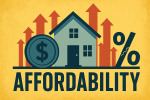By Dennis Norman, on May 7th, 2025 
According to a recent report by Realtor.com, Missouri and Illinois rank in the middle of the pack when it comes to home affordability, with Missouri landing at #22 and Illinois at #30 among all 50 states and the District of Columbia. While neither state earned a top grade, both remain relatively affordable compared to coastal and western markets. Missouri received a “C” grade with a REALTORS® Affordability Score of 0.82 and a median listing price of $298,696. Illinois, also graded “C”, had a slightly higher affordability score of 0.86, a median home price of $316,613, and a notably higher median Continue Reading →
By Dennis Norman, on September 4th, 2024 
In a newly released report by the Center for Demographics and Policy at Chapman University, St. Louis has been ranked the third most affordable housing market in the world for 2024. The Demographia International Housing Affordability report highlights that St. Louis continues to offer buyers some of the best value when it comes to housing, beating out major cities across the U.S. and globally.
For homebuyers in St. Louis, this is exciting news. While inflation and rising costs are still on the minds of many, the fact that the metro area remains such an affordable place to own a home Continue Reading →
By Dennis Norman, on August 5th, 2024 
According to a recent study by LendingTree, Missouri ranks 9th in the nation for the lowest monthly mortgage payment. The report reveals that while the average monthly payment on a new mortgage in the U.S. is $2,317, Missouri’s average monthly payment is $1,792. This makes Missouri’s payments approximately 23% less than the national average, positioning it favorably among states with more affordable housing costs. This is particularly notable considering the current economic climate, where mortgage rates remain relatively high, and home prices continue to be steep.
The LendingTree analysis, which examined mortgages offered across the nation from January 1 through Continue Reading →
By Dennis Norman, on April 11th, 2024 
The real estate market in St. Louis is notably diverse, featuring homes that are, on average, quite affordable. However, this affordability doesn’t preclude the existence of luxury markets within the city. Presented below is an exclusive list from MORE, REALTORS® detailing the top 10 cities in the St. Louis MSA where homes command the highest average selling prices.
Key takeaways from this list include:
Huntleigh dominates with the highest average sale price of $2,097,249 and impressively quick transactions, with homes spending an average of just 20 days on the market. It’s important to note that these figures are based on Continue Reading →
By Dennis Norman, on February 29th, 2024 
The dynamics of the new home market are shifting significantly as we advance into 2024, with a clear trend towards smaller, more personalized living spaces emerging nationwide. This evolution reflects a broader change in homeowner preferences and market conditions, according to the latest “What Home Buyers Really Want” study by the National Association of Home Builders (NAHB).
Recent data points to a decline in the average size of new homes, continuing a trend that began following a brief uptick in 2021. The average new home size has decreased to 2,411 square feet in 2023, marking the smallest average size in Continue Reading →
By Dennis Norman, on February 8th, 2024 The latest figures from the NAHB/Wells Fargo Housing Opportunity Index reveal that 70.8% of people in the St. Louis MSA, with a median income of $101,200, could afford to buy a median-priced home. This percentage has seen a slight increase from the 3rd quarter of 2023, when it was 69.3%. As demonstrated in the chart below, this positions St. Louis as the 31st most affordable metro area for home purchases, out of the 242 that were ranked.
Search St Louis Homes For Sale Search St Louis Upcoming OPEN HOUSES
St Louis MSA Housing Affordability & National Rank (2014-2023)
Continue Reading →
By Dennis Norman, on January 18th, 2024 Today, ATTOM released its ‘2024 Rental Affordability Report,’ presenting a comprehensive analysis of the current state of home rental and ownership in the United States. The report indicates that renting a median three-bedroom home is more affordable than owning a similarly-sized property in nearly 90% of the U.S. markets. This trend continues despite rents growing faster than home prices. A significant finding for our industry is that both renting and owning pose substantial financial burdens on average workers, consuming over a third of their wages in most county-level housing markets.
Data for St. Louis County is consistent with the report.
Continue Reading →
By Dennis Norman, on December 21st, 2023 A report just released by ATTOM Data Research details housing affordability for the largest counties in the St. Louis metro area for the 3rd quarter of 2023. Affordability, measured by the percentage of wages needed to buy a home, shows considerable variation across counties in Illinois and Missouri. This metric is influenced by factors such as median sales prices and average wages.
For instance, in the County of St. Louis City (yes, it’s odd, but it’s a county), it only takes 17.3% of the annualized wages of an average earner to buy a median-priced home. In contrast, in St. Charles Continue Reading →
By Dennis Norman, on November 14th, 2023 The 30-year fixed mortgage interest rate has experienced a significant drop, reaching 7.4% – the lowest since September 20th, nearly two months ago. This shift provides a much-needed reprieve in the housing market, particularly following the rate’s surge to 8.03% on October 19th, a peak unseen since August 7, 2000, 23 years ago.
The October high had introduced uncertainty and slowed down the real estate market, impacting buyer affordability and seller activity. The recent decline to 7.4%, though still high historically, is a positive sign, potentially reinvigorating interest and activity in the housing market.
This change in rates is key Continue Reading →
By Dennis Norman, on November 14th, 2023 In the world of real estate, down payments have emerged as a significant financial factor for homebuyers across the United States, and St. Louis is no exception. A recent report from LendingTree sheds light on the dynamics of down payments, and it’s essential for prospective buyers and sellers in St. Louis to understand how the local market fares in this regard.
St. Louis Down Payment Statistics:
St. Louis ranks 42nd out of the nation’s 50 largest metropolitan areas in terms of average down payments. This ranking places it 9th in terms of the lowest down payment amount in the 50 Continue Reading →
By Dennis Norman, on September 29th, 2023 As a result of rising interest rates and home prices at levels higher than increases in income, homes in St Louis continue to become less affordable. In fact, according to data just released by ATTOM Data Research, home affordability declined double digits during the 3rd quarter of this year in all five counties that make up the St Louis core market. As the info graphic below illustrates, the percentage of wages needed to buy a home have, depending upon county, increased about a third to almost half from the historical “norm”.
Least affordable ever…
Three of the five counties that Continue Reading →
By Dennis Norman, on March 25th, 2023 For the past several months there have been many reports anticipating the moves of the Federal Reserve regarding interest rates then followed by tons of articles, blog posts and videos analyzing then predicting the impact of the Fed’s decision on the economy. The other popular topic in this area is the “Money Supply”, usually M2 money supply and whether it’s increasing or decreasing as well as the impact on the economy.
Should St Louis homeowners and potential home buyers really care about the Fed Funds rate or M2 money supply?
First, let’s talk about the Fed Funds rate and what Continue Reading →
By Dennis Norman, on February 22nd, 2023 Today, the U.S. Department of Housing and Urban Development (HUD) announced a reduction in the mortgage insurance premium charged to borrowers on FHA loans. The mortgage insurance premium is a charge over and above the interest on the loan that is the fee to HUD for insuring the loan. Currently, the FHA mortgage insurance premium varies from 0.45% to 1.05% of the loan amount depending upon the loan term (15 or 30 years) and the LTV (loan to value). Effective with FHA mortgages endorsed for insurance by FHA on or after March 20, 2023, the rate will be reduced by Continue Reading →
By Dennis Norman, on January 19th, 2023 A report just released by ATTOM data shows that St Louis home prices are rising at a rate significantly higher than the rate wages in St Louis are rising and St Louis rental rates are increasing at rates higher than home prices. As the chart below shows, during the past year, wages in the St Louis metro area increased 3.8% however, home prices in St Louis increased 7.9% and rental rates increased 11.2%.
Search St Louis Homes For Sale Search St Louis Upcoming OPEN HOUSES St Louis MSA – Housing Affordability
Data source: ATTOM Data – Continue Reading →
By Dennis Norman, on November 9th, 2022 The National Association of Home Builders (NAHB) and Wells Fargo, jointly publish quarterly their Housing Opportunity Index (HOI) which shows the affordability, or lack thereof, of homes to a typical family. To arrive at an index value the median home price of recently sold homes for an area is taken into account as well as the median income for a family in that area. From this data the index is computed to show how affordable the typical home is to a typical family. The higher the index, the more affordable homes are to buyers in that market and the lower Continue Reading →
By Dennis Norman, on October 6th, 2022 A little over two weeks ago I wrote my most recent article addressing St Louis home prices titled “Will St Louis Home Prices Decline?” in which my short answer was “yes”, but kind of tongue in cheek and based upon the seasonality of home prices, but my longer answer was more vague. I mentioned that there certainly is a correction coming but pointed out that there are so many variables that will affect prices that it is hard to say to what extent this correction will be. While this is still true, a lot has happened in the short time Continue Reading →
By Dennis Norman, on September 20th, 2022 The short answer is yes. They decline every year as we head into winter due to the seasonal nature of the business. If you look at the first chart below which depicts the median price of homes sold in the St Louis 5-County core market since 1998, you will notice a very consistent pattern of prices rising in the spring and summer, then declining in the fall and winter. For the most part, the other pattern you will see is that the peak each spring is higher than the spring before and the bottom each winter is higher than the Continue Reading →
By Dennis Norman, on May 27th, 2022 
On May 12th the 30-year fixed rate mortgage interest rate hit 5.3%, the highest rates since June 2009, according to Freddie Mac’s Primary Mortgage Market Survey®. As the chart below illustrates, mortgage interest rate have declined the last two consecutive weeks falling to 5.10% yesterday, the lowest rate since April 28th.
There are more affordable options…
The chart I selected to show below also shows the mortgage interest rates for 15-year mortgages as well as something almost no one has had a reason to talk about for several years, adjustable rate mortgages (ARM’s). With mortgage interest rates as low as Continue Reading →
By John Donati, on February 24th, 2022 How ‘smart’ can a smart home be if its locks can’t tell you who is coming and going and when they came and went? In my opinion, that’s not a very ‘smart’ house. Nowadays, we use our phones for much more than talking to other people. To name a few, we use them for directions, email, and paying for groceries. So why wouldn’t we use them to remotely lock and unlock our doors too?
From my previous articles you might remember that one of the primary requirements in a smart home is either smart temperature control or a smart security Continue Reading →
By Dennis Norman, on May 5th, 2021 Lately, I’ve noticed several articles questioning whether the kind of crazy real estate market we’ve in for a while now is reminiscent of the early 2000’s which lead to a housing bubble that eventually burst in 2008. Granted, even in St Louis where we tend to not see the market extremes one way or the other like the coasts do, one could get the idea that maybe we’re headed that way with buyer’s fighting over new listings and bidding wars that have homes often selling for over the list price. However, in my humble opinion, this market is very different Continue Reading →
By Dennis Norman, on February 20th, 2021 One of the many benefits to living in St Louis is it’s a very affordable place to live and much easier to be a homeowner than in most other major metro areas. Having said that, we do have areas, such as Ladue, Huntleigh, and Clayton to name a few where we do see home prices that are out of reach for most of the folks living here. One such example is a magnificent 10,000+ square foot Ladue manse that sold earlier this month. At a final sales price of $6,150,000, it is the highest-priced home sale in the REALTOR® MLS Continue Reading →
By Dennis Norman, on January 25th, 2021 One of the benefits to living in St Louis we often hear about is how affordable it is compared with many other metro areas around the country. Granted, one of the things that contribute to the “affordability” is the price of homes but that doesn’t mean we don’t have areas with pricey real estate here. The list below is part of the list showing what the average price homes sold for in every municipality in the St Louis MSA during the past 12 months and reveals the five municipalities where the average home price exceeded $1 Million.
Leading the list Continue Reading →
By Dennis Norman, on July 2nd, 2020 Not only has it become common today for homes to sell as soon as they hit the market but receiving offers from multiple buyers and at prices that equal or even exceed the asking price is common as well. While this is an illustration of Economics 101, the rule and supply and demand, when the demand exceeds the supply (such as in the housing market in many price ranges and areas), prices increase this can also be a reminder of times past when home prices rose quickly for several years, then retreated rather abruptly. The most recent example of Continue Reading →
By Dennis Norman, on May 14th, 2020 The St Louis real estate market continues to be on the upswing and recovering from the impact of COVID-19. The pandemic did slow the St Louis real estate market down for a while but it appears to be recovering quite quickly. Get all of this and more in this month’s update. Interest rates, the “cherry on top”. In case the market rebound isn’t enough, mortgage interest rates are at near historic lows making now a great time, and an affordable time, to buy a house if you are in a position to do so. [xyz-ips snippet=”Market-Update-Video-Package”] [xyz-ips snippet=”Seller-Resources—Listing-Targeted”] Continue Reading →
By Dennis Norman, on March 28th, 2020 Homes became more affordable in Jefferson County and St Charles County during the first quarter of this year from the 4th quarter of 2019, according to data just released by ATTOM Data Research. As the table below shows, the affordability index for both those counties increased from the prior quarter as well as from the same quarter the prior year. Franklin County’s affordability index was the same for the 1st quarter of 2020 as the prior quarter but improved by 5% from a year ago. The two St Louis’s, the city and county, both saw decline in home affordability from Continue Reading →
By Dennis Norman, on February 23rd, 2020 Let me begin with this is not a political statement and the purpose of this site is not about politics but about real estate. Having said that, this morning I came across the plans for the housing market that Bernie Sanders is proposing if he is elected President which I had not seen before. Upon reviewing his plan (it is on his official site) I realized that while many of the components of it sound good (like “End homelessness and ensure fair housing for all”) many of his promises in this area sound like things that would negatively impact investors Continue Reading →
By Dennis Norman, on September 26th, 2019 Home affordability improved in the St. Louis metro area during the 3rd quarter, with 4 of the 7 largest counties seeing an improvement in their affordability index from the prior quarter and 5 of the 7 seeing an improvement in affordability from a year ago, according to the latest data from ATTOM Data Research.
The greatest improvement in affordability was in Franklin County.
As the table below shows, Franklin County saw a 12% improvement in housing affordability from the prior quarter and an 11% improvement from a year ago. Jefferson, St Charles and St Clair (IL) County saw improvements in Continue Reading →
By Dennis Norman, on August 28th, 2019 You are probably saying I’m nuts to be saying that a home in St Louis costs less today than it did 13 years ago, back in 2006, but, note I said the “real cost” of a home. Since nearly all people buying a typical home in St Louis are going to do so with a mortgage, I think to really determine the cost of a home, and certainly, it’s affordability, we have to look deeper than just the price. Therefore, as the table below shows, I analyzed the cost of a home in St Louis during two periods of time, Continue Reading →
By Dennis Norman, on August 8th, 2019 St Louis may be the 8th most affordable metro area in the country to buy a home, but it also has areas where home prices are much higher as well. The median price of homes sold in the St Louis metro area during the past 12-months is $184,500 however the average price of homes sold within the past 12-months has exceeded this in 85 of the 205 municipalities within the St Louis MSA.
Below is our list of the 30 cities with the highest average price of homes sold during the past 12 months. St Louis County has the majority Continue Reading →
By Dennis Norman, on June 29th, 2019 Home affordability declined in the City of St Louis from a 98 on the affordability index in the first quarter to an index of 73 this quarter, for a decline of 25% in home affordability in the City of St Louis, according to the latest data from ATTOM Data Research. In neighboring St Louis County, the affordability was 116 in the first quarter and 89 the 2nd quarter, for a decline of 23%. On the affordability index, anything under 100 indicates homes are less affordable than the historical average and anything over 100 indicates homes are more affordable than the Continue Reading →
|
Recent Articles
Helpful Real Estate Resources
|








